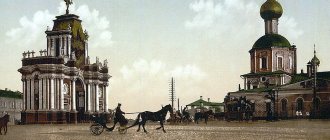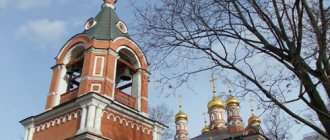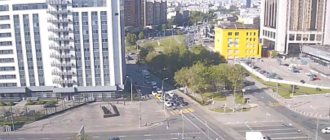The zero kilometer of highways of the Russian Federation in Moscow is a special mark from which road distances are counted. It is located in the historical center of the city, on Manezhnaya Square, in the passage between the buildings of the State Historical Museum and the City Duma.
Despite its enormous popularity, the monument only symbolizes the starting point of the length of the road routes. The actual zero kilometer is located slightly to the north. And this sign is simply an interesting tourist attraction and a favorite place for residents and guests of the Russian capital.
Where is the Zero Kilometer of Moscow?
Road reference points exist in many cities and states. They usually look like signs on the ground, signs, plaques, steles, or may be marked by some kind of architectural landmark. For example, a bridge, tower or residential building. And according to Wikipedia, their locations are often quite arbitrary.
© Gone Postal
The tradition of marking the beginning of paths dates back to ancient Roman times. The first such symbol was the “Golden Milestone” (Milliarium Aureum), a gilded bronze column erected in 20 BC. e. All the main roads of the Holy Roman Empire led from it.
The Moscow monument, symbolizing the zero kilometer, was installed only in 1996. However, the bronze parts of the composition were made back in the 1980s. and were planned for installation on Red Square, between GUM and the Mausoleum of V.I. Lenin, but negotiations for some reason dragged on and the metal structure until the mid-1990s. was in storage.
In 1995, the issue of placing the sign was returned to. The capital's authorities chose from fourteen possible locations, including Red, Tverskaya and Teatralnaya squares.
As a result, the zero kilometer was installed in one of the most historical places in Moscow, at the Resurrection Gate.
There are many significant attractions around it: Red Square, the Kremlin, the State Historical Museum, GUM, Central Manezh, Bolshoi Theater, Alexander Garden, St. Basil's Cathedral.
© and-dem-public
Most guests and residents of the capital are sure that road distances from Moscow were actually counted from this point. But this is not true. In the Russian Empire, the beginning of all paths was on the street. Myasnitskaya, near the building of the Moscow Post Office, located there since the end of the 16th century. And during the transfer of capital functions to St. Petersburg, the zero kilometer for almost 200 years, from 1814 to the beginning of the 20th century, was located in the main post office of the northern city.
The tradition of measuring the distance between settlements from post offices is associated with the use of horse-drawn carts. They transported mail from one post office to another. But with the advent of radio, it became possible to transmit information by wire. And it became more logical to count roads from telegraphs.
Today, the calculation of road routes from the Russian capital is carried out from the Central Telegraph at the intersection of st. Tverskaya and lane Newspaper. But in reality, the city has not one, but two zero kilometers. The Moscow Ring Road (MKAD) also has a mileage reference point, which is located at the intersection of the main highway with Entuziastov Highway.
By the way, the railway has its own mark for the start of distances, separate from the roads. It is located between tracks No. 3 and No. 4 at the Yaroslavl station, where the longest railway in the world, the Trans-Siberian Railway, starts.
© Roman Vorobiev
Kilometer Zero sign - where is it actually located?
Well, of course, you all know about the coin.
Or not?
Okay, then first about the coin.
For your wish to come true, the following conditions must be met:
- Stand strictly IN THE CENTER
- BACK to the Resurrection Gate
- CLOSE YOUR EYES
- Throw over your LEFT shoulder
- BIGGER coins are better (they say it doesn’t come true for the greedy)
The deadline for “fulfilling the application,” according to urban folklore, is within a year or several years.
Guess what I mean? Of course, about the sign “Zero kilometer of roads of the Russian Federation”.
It was installed in 1996 in front of the Iveron Chapel, a stone's throw from Red Square. It has no practical significance - the countdown from it is not carried out and has never been carried out.
In reality, the countdown was carried out from the following points:
- Since the 15th century (and it was then that it became necessary to count, since the Yamskaya service with flat payment appeared) - from the main Yamskaya station.
- In Peter's times - from the Moscow Post Office on Myasnitskaya Street.
- In the 19th century - from the building of the Provincial Administration in Voskresensky Proezd.
- In Soviet times until 1959 - from the Central Telegraph on Tverskaya Street.
- Since 1959 - from the Mausoleum of V.I. Lenin and I.V. Stalin on Red Square.
In 1982, they decided to erect a symbolic sign on Red Square, near the GUM building, in alignment with the Lenin Mausoleum.
In 1986, the design of the sign was ready, but it was installed only 10 years later, and not in the planned location, but in the passage of the Resurrection Gate.
The mayor's office did not specify the exact reasons for the change of location, but there were rumors that this was required by the Kremlin security, so as not to create a reason for gatherings on Red Square.
The original location also explains the appearance of the sign itself. It was made by sculptor A.I. Rukavishnikov and architect I.N. Voskresensky. The task before them was difficult - the sign on Red Square should not disturb its historical ensemble and at the same time be visible to everyone. This is not a milestone for you to build...
The authors solved the project ingeniously - they made a sign in the form of a planar composition, mounted flush into the paving stones.
What do the “icons” on the zero kilometer sign mean?
The basis of the sign is a square divided into 4 sectors.
In the sectors there are relief images of characteristic representatives of the fauna and flora of the 4 geographical directions of the world.
North - polar owl, deer, fur seal, cloudberry.
South - mountain goat, vulture, dolphin, tangerines.
West - black grouse, bison, eel, oak.
Vostok - Ussuri tiger, puffin bird, Central Asian cobra and Siberian cedar.
True, Muscovites, who don’t feed them bread, let them come up with a nickname for the monuments, immediately nicknamed the sign “a sewer manhole.” But this does not bother anyone, and coins of large and small denominations continue to fly over the shoulders of tourists.
Monument design
The Moscow zero kilometer sign on the Voskresenskie Gate passage was made according to a joint project of the famous Russian architect I. N. Voskresensky and the master of monumental and easel compositions A. I. Rukavishnikov.
It is made in the shape of a compass with the symbol “Wind Rose” and the number “0” in the middle (already worn out by the feet of numerous tourists). The symbol is bordered by the inscription “Zero kilometer of highways of the Russian Federation.”
Along the edges of the bronze patch, built into the paving stones, there are four arrow corners. They depict animals characteristic of the fauna of the regions of the corresponding parts of the world. Typical for the north are deer, polar owl and seal, for the south - dolphin, aurochs, vulture, west - capercaillie, bison and eel, east - cobra, tiger and toucan. All this is surrounded by a bronze circle, included in a square of dark tiles.
Signs of cardinal directions, © Gone Postal
Customs
Despite the fact that the attraction appeared relatively recently, an interesting tradition has taken root among the residents of Russia. Every day many people come to the monument, wanting not only to look at the starting point of all the paths, but also to make a wish.
It is believed that if you throw a coin from the central bronze mark, your dream will come true. But it needs to be done accordingly. You need to stand facing the Iveron Chapel (although tourists usually turn their backs to it to get great photos) and throw a coin over your left shoulder with your left hand. You should make a wish on one leg, with your eyes closed. The fallen penny must remain within the metal circle; its value does not matter.
This custom appeared because travelers used to come to this place to worship the Iveron Chapel. A copy of the miraculous icon of the Mother of God (Goalkeeper, Gatekeeper) was kept in it for a long time. People asked the intercessor for protection on the road and from here they set off on a long journey.
© elena17-05
Traditions
Foreigners and tourists from Russia traditionally take photographs near the mark as a souvenir. Making a wish remains the most popular tradition, which is why the area around the zero kilometer of Moscow is always crowded. It is considered a good sign to stand on one leg exactly in the middle of the sign and throw a coin over your shoulder with your left hand so that it does not roll out beyond the boundaries of the square frame of the mark, laid out from dark tiles. The gaze at this time should be turned to the Iveron Chapel. Tourists believe that if they managed to do everything exactly this way, then the wish made at this place will certainly come true.
Nobody knows for sure where this tradition came from. It is especially surprising that this ritual is associated with such a young work of art, because beliefs and legends are more characteristic of elements of antiquity. Nevertheless, it is near this landmark that you can regularly see a crowd of people throwing coins over their shoulders. True, the money will be immediately raised by one of the tramps who are constantly on duty here.





